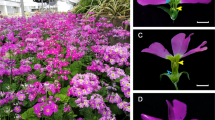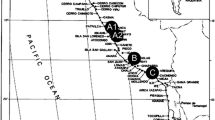Abstract
Ceratostigma willmottianum (Plumbaginaceae) is a perennial herb native to China. Many species of Plumbaginaceae have been reported to exhibit heterostyly. Determining the functional breeding system of C. willmottianum can improve our understanding of the reproductive ecology of heterostylous plants. We investigated the floral traits and pollen and stigma characteristics in a natural population, and artificial pollination was carried out in an artificial population. It was found that C. willmottianum was distylous with short (S)- and long (L)-styled morphs, did not exhibit precise reciprocal herkogamy and was partially self-compatible but primarily outcrossing. In the artificial pollination experiments, the pollen tubes reached the base of the style under intermorph pollination, whereas they rarely penetrated the style under intramorph pollination and self-pollination. Both the L and S morphs exhibited a high seed set after intermorph pollination, whereas the seed set under intramorph pollination was lower. Therefore, C. willmottianum may spread the chance of receiving pollen between the two morphs by nonreciprocal heterostyly, which may be a unique mode of ecological adaptation in Plumbaginaceae. We believe that our discovery could provide new ideas regarding the origin and evolution of heterostyly.










Similar content being viewed by others
Abbreviations
- Self-pollination:
-
Self-pollination (L♀ × L♂ or S♀ × S♂)
- Intrapollination:
-
Intramorph pollination (L♀ × L'♂ or S♀ × S'♂)
- Interpollination:
-
Intermorph pollination (S♀ × L♂ or L♀ × S♂)
- HetSI:
-
Heterotypic self-incompatibility
- HomSI:
-
Homomorphic self-incompatibility
- P/O ratio:
-
Pollen/ovule ratio
- OCI:
-
Outcrossing index
- ESEM:
-
Environmental scanning electron microscope
References
Arzani K, Nejatian MA, Karimzadeh G (2005) Apricot (Prunus armeniaca) pollen morphological characterisation through scanning electron microscopy, using multivariate analysis. New Zealand J Crop Hort Sci 33:381–388
Bahadur B (1970) Heterostyly in Hedyotis nigricans (Lam) Fosb. J Genetics 60:175
Barrett SC (2002) The evolution of plant sexual diversity. Nat Rev Genet 3:274–284
Barrett SCH, Shore JS (2008) New insights on heterostyly: comparative biology, ecology and genetics. Self-incompatibility in flowering plants. Springer, Berlin, Heidelberg, pp 3–32
Bremer B, Manen JF (2000) Phylogeny and classification of the subfamily Rubioideae (Rubiaceae). Plant Syst Evol 225:43–72
Castro CC, Araujo AC (2004) Distyly and sequential pollinators of Psychotria nuda (Rubiaceae) in the Atlantic rain forest, Brazil. Plant Syst Evol 244:131–139
Charlesworth D, Charlesworth B (1979) A model for the evolution of distyly. Am Nat 114:467–498
Chen L, Yang C, Huang H (2009) Comparison of detection methods for pollen viability of Hemarthria compressa. Exp Technol Manag 1:39–41
Chen M, You Y, Zhang X (2010) Advances in the research of heterostyly. Acta Pratacult Sin 19:226–239
Cruden RW (1977) Pollen–ovule ratios: a conservative indicator of breeding systems in flowering plants. Evolution 31(1):32–46
Dafni A (1992) Pollination ecology: a practical approach. Oxford University Press, Oxford
Darwin C (1897) The different forms of flowers on plants of the same species. D. Appleton and Company, New York
Dorken ME, Eckert CG (2001) Severely reduced sexual reproduction in northern populations of a clonal plant, Decodon verticillatus (Lythraceae). J Ecol 89(3):339–350
Dulberger R (1975) Intermorph structural differences between stigmatic papillae and pollen grains in relation to incompatibility in Plumbaginaceae. Proc R Soc Lond B Biol Sci 188:257–274
Dulberger R (1992) Floral polymorphisms and their functional significance in the heterostylous syndrome. Evolution and function of heterostyly. Springer, Berlin, Heidelberg, pp 41–84
Dulberger R, Ornduff R (2000) Stigma morphology in distylous and non-heterostylous species of Villarsia (Menyanthaceae). Plant Syst Evol 225:171–184
Faivre AE, Mcdade LA (2001) Population-level variation in the expression of heterostyly in three species of Rubiaceae: does reciprocal placement of anthers and stigmas characterize heterostyly? Am J Bot 88:841–853
Ferrero V, De Vega C, Stafford GI, Van Staden J, Johnson SD (2009) Heterostyly and pollinators in Plumbago auriculata (Plumbaginaceae). South Afr J Bot 75:778–784
Gandadikusumah VG, Wawangningrum H, Rahayu S (2017) Pollen viability of Aeschynanthus tricolor Hook. J Trop Life Sci 7:53–60
Ganders FR (1979) The biology of heterostyly. New Zealand J Bot 17:607–635
Harder LD, Johnson SD (2009) Darwin’s beautiful contrivances: evolutionary and functional evidence for floral adaptation. New Phytol 183:530–545
Hu J, Gao S, Liu S, Hong M, Zhu Y, Wu Y et al (2019) An aseptic rapid propagation system for obtaining plumbagin of Ceratostigma willmottianum Stapf. Plant Cell Tissue Organ Cult 137:369–377
Jian MY, Yu Z, Jun X, Zhong WL, Han DS (1997) A new glucoside from Ceratostigma willmottianum. Chinese Chem Lett 8:873–874
Kunin WE (1993) Sex and the single mustard: population density and pollinator behavior effects on seed-set. Ecology 74:2145–2160
Levin DA (1972) Competition for pollinator service: a stimulus for the evolution of autogamy. Evolution 26:668–669
Li Y, He X, Liao S, Wang A, Lan Y, Huang Y, Wang Y (2008) Study on the preparation of chemical reference of Ceratostigma willmottianum Stapf. J Guiyang Med College 6:622–624
Lloyd DG, Webb CJ (1992) The evolution of heterostyly. Evolution and function of heterostyly. Springer, Berlin, Heidelberg, pp 151–178
Lobato-de Magalhães T, Martínez M (2020) Insights into distyly and seed morphology of the aquatic plant Nymphoides fallax Ornduff (Menyanthaceae). Flora 262:151526
Lu QZ, Deng W, Tian HP, Li SK (2014) Study on the ethnic medicine Ceratostigma willmottianum Stapf for its analgesic and anti-inflammatory effects and acute toxicity test. Guizhou Sci 1(26–28):39
Luo S, Zhang K, Zhong WP, Chen P, Fan XM, Yuan DY (2020) Optimization of in vitro pollen germination and pollen viability tests for Castanea mollissima and Castanea henryi. Sci Hort 271:109481
Mahmoudi M, Boughalleb F, Pellegrino G, Abdellaoui R, Nasri N (2020) Flower, seed, and fruit development in three Tunisian species of Polygonum: implications for their taxonomy and evolution of distyly in Polygonaceae. PLoS One 15:e0227099
Martin AJ, Bigwood RF (1969) Rapid fluorescent-antibody staining technique. Appl Microbiol 17:14–16
Raza J, Ahmad M, Zafar M, Athar M, Sultana S, Majeed S et al (2020) Comparative foliar anatomical and pollen morphological studies of Acanthaceae using light microscope and scanning electron microscope for effective microteaching in community. Microscopy Res Tech 83:1103–1117
Takayama S, Isogai A (2005) Self-incompatibility in plants. Annu Rev Plant Biol 56:467–489
Tekleva M (2016) Pollen morphology and ultrastructure of several Gnetum species: an electron microscopic study. Plant Syst Evol 302:291–303
Washitani I, Osawa R, Namai H, Niwa M (1994) Patterns of female fertility in heterostylous Primula sieboldii under severe pollinator limitation. J Ecol 82:571–579
Watanabe K, Yang TA, Nishihara C, Huang TL, Nakamura K, Peng CI, Sugawara T (2015) Distyly and floral morphology of Psychotria cephalophora (Rubiaceae) on the oceanic Lanyu (Orchid) Island. Taiwan Bot Stud 56:10
Weller SG, Ornduff R (1977) Cryptic self-incompatibility in Amsinckia grandiflora. Evolution 31(1):47–51
Xu XY, Zhou LL, Wang ZK, Zhuang L (2015) Flower distyly and breeding system of Limonium chrysocomum. Bulletin Bot Res 35(6):883–890
Yang CD, He XZ, Gou GQ (2018) Ophiorrhiza guizhouensis (Rubiaceae), a new species from Guizhou Province, southwestern China. PhytoKeys 95:121
Zhang S, Gao SP (2014) Distyly and selfing incompatibility of Plumbago auriculata. Guihaia 34:747–753
Zhang W, Zhou B, Xiao Y, Yan X, Zhang Z, Li X (2013) Reproductive ecology of distylous Fagopyrum dibotrys. Acta Bot Boreali-Occidental Sin 33:483–493
Zhang C, Wang LL, Duan YW, Lan D, Yang YP (2014) Pollination ecology of Arnebia szechenyi (Boraginaceae), a Chinese endemic perennial characterized by distyly and heteromorphic self-incompatibility. Ann Bot Fennici 51:297–304
Funding
National Key R&D Program of China (2018YFD0600105). Sichuan Science and Technology Program (2016NYZ0038).
Author information
Authors and Affiliations
Contributions
Conceptualization, Suping Gao; methodology, Meiting Hong; validation, Ting Lei; formal analysis, Wenji Li.; investigation, Ping Shen; data curation, Jiani Li; writing—original draft preparation, Wenji Li and Meiting Hong; writing—review and editing, Suping Gao; supervision, Mingyan Jiang; project administration, Yifan Duan and Lisha Shi.
Corresponding author
Ethics declarations
Conflicts of interest
The authors have no conflicts of interest to declare.
Additional information
Publisher's Note
Springer Nature remains neutral with regard to jurisdictional claims in published maps and institutional affiliations.
Rights and permissions
About this article
Cite this article
Gao, S., Li, W., Hong, M. et al. The nonreciprocal heterostyly and heterotypic self-incompatibility of Ceratostigma willmottianum. J Plant Res 134, 543–557 (2021). https://doi.org/10.1007/s10265-021-01269-5
Received:
Accepted:
Published:
Issue Date:
DOI: https://doi.org/10.1007/s10265-021-01269-5




